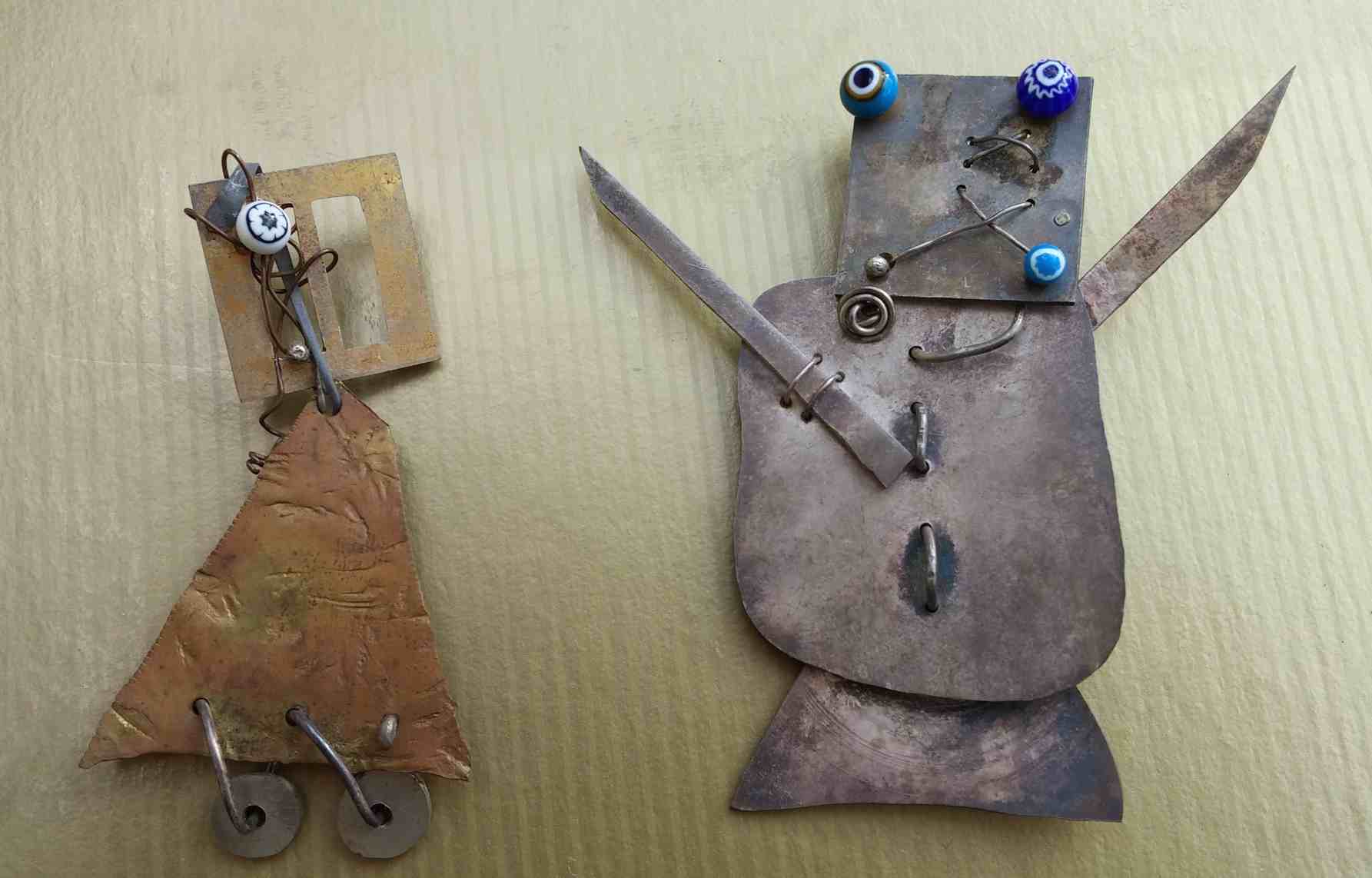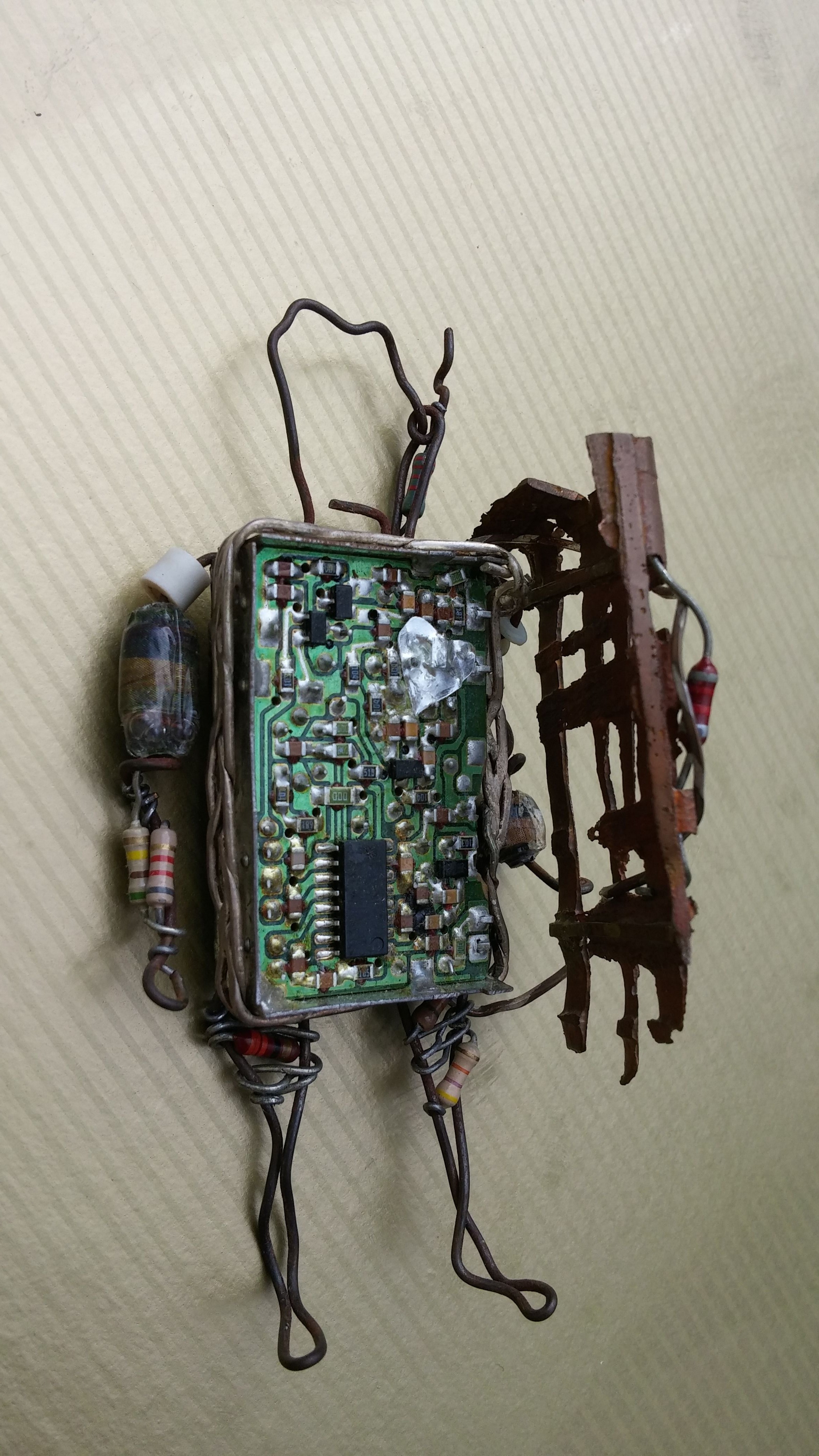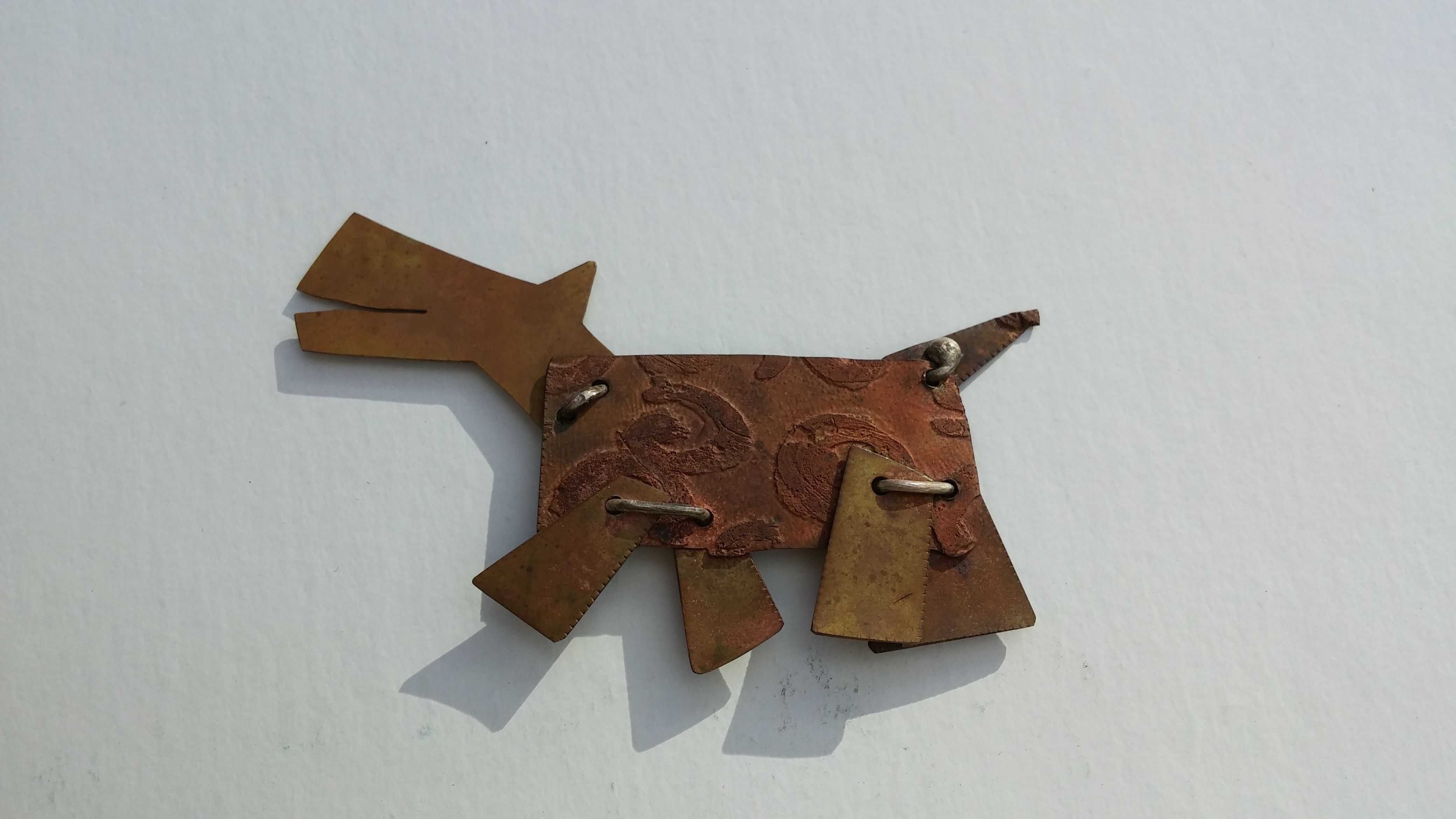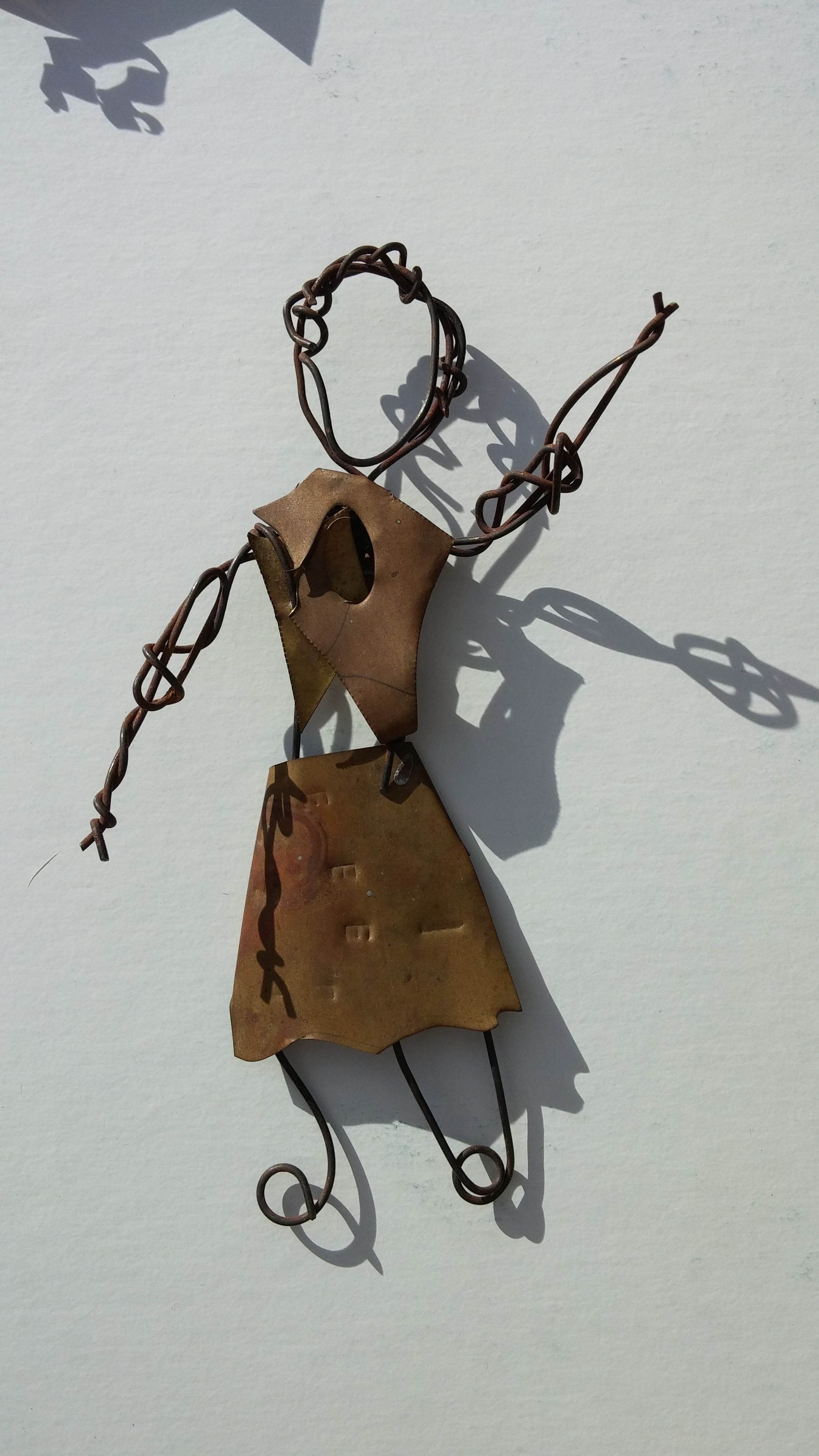I decided to use the Categories for the Description of Works of Art (CDWA) developed by the Getty Trust to develop metadata for a collection of small metal figures and their associated visual and group records. These items are in my private collection, and they were also constructed by me. This was for a class I took in Metadata. The cataloging rules in CDWA can be rather specific in some areas and requires certain fields to be used based on the presence of others. For example, rules like this appear in more than one spot:
The cataloging rules in CDWA can be rather specific in some areas and requires certain fields to be used based on the presence of others. For example, rules like this appear in more than one spot:
If the subject refers to function, you may record the same term in OBJECT/WORK – TYPE. If the TITLE refers to subject, the subject must also be recorded in SUBJECT MATTER. “ (CDWA, 16. Subject Matter).
The CDWA specifies vocabularies and several outside vocabularies that can be used. The Arts and Architecture Thesaurus (AAT, 2017) by the Getty Trust is listed first and most often, but many others can be used. Cataloging Cultural Objects: A Guide to Describing Cultural Works and Their Images (CCO), by the Visual Resources Association (VRA, 2006) is suggested as a means of understanding the categories at their top level, while the vocabularies are employed in the sub-categories.
CDWA is also usable with CDWA Lite, a schema that is intended for transmission via the Open Archives Initiative (OAI) harvesting protocol.
Cataloging these items was challenging at times for several reasons. The exhaustive and duplicative categories made for a fair amount of data entry. Consistently applying the cataloging rules was tricky at times, as the record is supposed to have some matching data within the record itself and terms from free text fields are supposed to be indexed in the Authority Section. Selection of a system to generate CDWA records would need to have logic built in to check for inconsistencies, and would ideally create relationships based on the presence of related metadata.
There was also the emotional and cognitive load of indexing something that I was also the creator of. I found myself striving for the most accurate descriptive terms from the AAT and the built-in vocabularies which often left me feeling dissatisfied. For example, I wanted to include the term postmodern, but it was not part of the vocabulary. I also thought about how some terms might be influenced by the 15 years that have gone by since I made these items. It was hard sometimes to be objective, and where I succeeded in objectivity, I felt I failed in description. My free-text descriptions did get longer, and I feel I mastered some (not all) of the cataloging rules as I progressed through the project.
I could have described each of these more deeply. I was intrigued by the nested structure of some of the fields, particularly for place. One can include administrative entities such as cities or states, as well as environmental ones relating to landscape. I wondered however, could I narrow the place description down to the immediate? I started to think as I recorded the broader regions of time and space where the creation of these works took place, that this was also the space to record the intimate details of my surroundings; the dark blue carpet and crisp white walls of my studio; the trees outside the window and the ambient sounds of traffic passing by. Then there was the small universe on my workbench. A landscape of tools, metal, and soldering blocks. Important notes like a recipe for homemade flux and a guideline to the Brown and Sharpe gauge were committed to squares of thin brass with letter punches and then tacked to the workbench with nails. Shortly after making these I would pack up all my tools and move far away. I created so much artwork there that it seems important to include this, but it seemed possibly extraneous so I did not.
Here is a simple CDWA record for one of my sculptures:
| Category | Values |
| 1. Object/Work |
An animal figure in mixed metals.
|
| 1.1. Catalog Level | item |
| 1.2. Object/Work Type |
direct metal sculpture
|
| 1.3 Object/Work Date | 1998-2002 |
|
1.4 Components/Parts
|
|
|
1.4.2 Components Type
|
|
| 1.5 Remarks | |
| 2. Classification | sculpture |
| 2.1 Classification Term | sculpture |
| 2.2 Remarks |
A direct metal sculpture depicting a dog.
|
| 3. Titles or Names |
Misty; Brass Dog
|
| 3.1 Title Text | Misty |
| 3.2 Title Type | preferred |
| 3.3 Preferred Title | Misty |
| 3.4 Title Language | English |
| 4. Creation | |
| 4.1. Creator Description |
Ellen Mooney Phillips (American jeweler, 1969-)
|
| 4.1.3. Creator Identity |
Phillips, Ellen Mooney
|
| 4.1.4. Creator Role |
metalworker; jeweler; sculptor
|
| 4.2. Creation Date | 2000 |
| 4.2.1. Earliest Date | 1998 |
| 4.2.2. Latest Date | 2002 |
| 4.3. Creation Place/Original Location |
Nashua, NH, USA
|
| 4.4. Object/Work Culture | American |
| 5. Styles/Periods/Groups/ Movements |
contemporary |
| 5.1. Styles/Periods Description |
Direct metal sculpture created at the end of the 20th century and after the dot-com technology bubble.
|
|
5.2. Styles/Periods Indexing Terms
5.2.1. Style/Period Indexing Type 5.3. Remarks |
|
|
6. Measurements
|
|
| 6.1. Dimensions Description |
4cm (bottom of paws to top of back) x7cm (snout to tail)
|
|
6.2. Dimensions Type
6.3. Dimensions Value 6.4. Dimensions Unit 6.5. Dimensions Extent |
|
|
7. Materials/Techniques
|
|
| 7.1. Materials/Techniques Description |
Constructed from 22 gauge brass and 18 gauge etched brass.
|
|
7.2. Materials/Techniques Flag
|
|
|
7.3. Materials/Techniques Extent
|
|
|
7.4. Materials/Techniques Role
|
|
|
7.5. Materials/Techniques Name
|
|
|
7.10. Remarks
|
|
|
8. Inscriptions/Marks
8.1. Inscription Transcription or Description 8.2. Inscription Type 8.3. Inscription Author 8.4. Inscription Location 8.5. Inscription Language 8.6. Typeface/Letterform 8.7. Mark Identification 8.8. Inscription Date 8.8.1. Earliest Date 8.8.2. Latest Date 8.9. Remarks 8.10. Citations 8.10.1. Page |
|
| 11. Facture | |
| 11.1. Facture Description |
Dog constructed in seven pieces using cold connections to join sheet metal components. The body was cut from an etched brass piece. The tail was hammer and heat textured.
|
|
11.2. Remarks
|
|
|
11.3. Citations
|
|
| 13. Physical Description 13.1. Physical Appearance 13.2. Physical Description Indexing Terms 13.3. Remarks |
Dog (canine) constructed using with direct metal construction. The head, legs and tail are articulated to a certain degree.
|
|
15. Conservation/Treatment
History 15.1. Conservation/Treatment Description 15.2. Treatment Type 15.3. Treatment Agent 15.4. Treatment Date |
|
|
16. Subject Matter
|
|
|
16.1. Subject Display
|
|
| 16.2. General Subject Terms | animal |
| 16.2.1. General Subject Type | identification |
| 17. Context | |
| 18. Descriptive Note |
See 13 Physical Description
|
| 20. Related Works |
Robots (group)
|
|
20.1. Related Work Label/Identification
|
|
|
20.1.1. Work Relationship Type
20.1.2. Work Relationship Date 20.1.2.1. Earliest Date 20.1.2.2. Latest Date 20.2. Work Broader Context |
|
|
20.2.3. Hierarchical Relationship Type
20.3. Relationship Number 20.4. Remarks |
|
| 21. Current Location |
private collection
|
| 21.2. Repository/Geographic Location |
Chester, NH, USA
|
|
21.2. Repository/Geographic Location
21.2.1. Current Flag 21.2.2. Location Type 21.2.3. Repository Numbers |
|
| 22. Copyright/Restriction |
Copyright Ellen Mooney Phillips 2018. Some rights reserved. You are free to: Share — copy and redistribute the material in any medium or format as long as you give me credit for the original idea/design. Creative Commons License Info: Attribution-NonCommercial-NoDerivatives 4.0 International (CC BY-NC-ND 4.0) https://creativecommons.org/licenses/by-nc-nd/4.0/
|
|
22.1. Copyright Statement
22.2. Copyright Holder Name 22.3. Copyright Place 22.4. Copyright Date 22.4.1. Earliest Date 22.4.2. Latest Date 22.5. Remarks |
|
|
25. Cataloging History
25.1. Cataloging Institution 25.2. Cataloger Name |
|
|
26. Related Visual Documentation
[references to the Object/Work] |
|
| 26.1. Image References |
Individual and group images available here: http://ellenmetal.com/blog/robots/; Photos of this dog are records number 2 and 3 of this project
|
| 26.1.1. Work Relationship Type |
documentary image; study image
|
|
[Image Authority information]
26.2. Image Label/Identification 26.2.1. Image Catalog Level 26.2.2. Image Type 26.2.3. Image Title/Name 26.2.3.1 Image Title Type 26.2.4. Image Measurements 26.2.4.1. Dimension Type 26.2.4.2. Dimension Value 26.2.4.3. Dimension Unit 26.2.5. Image Format 26.2.6. Image Date 26.2.8. Works Depicted 26.2.12. Image Copyright/Restrictions 26.2.12.1. Image Copyright Holder |
|
|
[references to the Object/Work]
27. Related Textual References |
|
| [Citations Authority information] 27.2. Source Brief Citation |
Robots by Ellen Mooney Phillips. http://ellenmetal.com/blog/robots/
|
| 27.2.2. Source Full Citation |
Phillips, E., Robots by Ellen Mooney Phillips. (2018) [Blog Post] Retrieved from http://ellenmetal.com/blog/robots/
|
|
28. Person/Corporate Body Authority [core subcategories]
|
|
| 28.2. Person/Corporate Body Name |
Ellen Mooney Phillips
|
| 28.2.8. Name Source |
Robots by Ellen Mooney Phillips. http://ellenmetal.com/blog/robots/
|
| 28.3. Display Biography |
American, jeweler, 1969-
|
| 28.4. Birth Date | 1969-12-13 |
|
28.5. Death Date
|
|
| 28.8. Person Nationality/Culture/Race | American |
| 28.10. Life Roles |
jeweler; metalworker; librarian
|
| 29. Place/Location Authority (Record Type) |
Nashua, NH, USA
|
| 29.2. Place Name |
USA, NH, Nashua ; United States, Northeast
|
| 29.2.8. Name Source |
Google Maps. https://www.google.com/maps
|
| 29.4. Place Types |
place of residence; city : place of residence; geographic region
|
| 29.6. Place Broader Context |
Nashua (Hillsborough County, New Hampshire, United States) (inhabited place)
|
|
30. Generic Concept Authority
|
|
| 30.2. Generic Concept Term |
direct metal-sculpture; anti-modernism; artistic change; figurative art; objets d’art; outsider art; handmade
|
| 30.2.8. Term Source |
AAT, Objects Facet; Robots by Ellen Mooney Phillips. http://ellenmetal.com/blog/robots/
|
| 30.2. Generic Concept Term |
metalworker; jeweler; sculptor
|
| 30.2.8. Term Source |
AAT “About” by Ellen Mooney Phillips. http://ellenmetal.com/blog/hello/.
|
| 30.4. Concept Broader Context |
See definitions in AAT, blog posts, and general popular culture references from 1990-2010.
|
| 30.6. Concept Scope Note |
Terms should be used to describe how the item was made, the motivation of the artist, and societal forces at play during the time period in which it was created.
|
| 30.6.1. Note Source |
AAT; Robots by Ellen Mooney Phillips. http://ellenmetal.com/blog/robots/
|
|
31. Subject Authority
|
|
| 31.2. Subject Name | |
| 31.2.8. Name Source | AAT |
| 31.6. Subject Broader Context |
AAT Objects Facet
|


